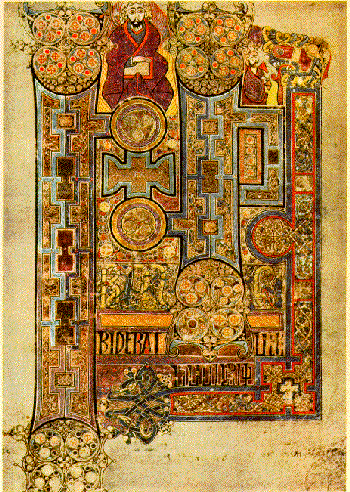St Patrick
St. Patrick (AD 385-462) was
captured and enslaved in Ireland as a youth,
escaped, and finally returned as an adult to
spread Christianity as a Catholic missionary. He
was not Irish by birth, but was believed by some
accounts to be either the son of a Roman Officer,
or a British Celt. In his confession, one of
the few documents known to be written by Patrick,
he describes his father as "Calpornius, a deacon, son
of Potitus, a priest, of the village Bannavem
Taburnić"
In
legend, Patrick is given credit for driving the
snakes out of Ireland. In reality, the 'snakes'
may well refer to the Druids, who were
discredited and finally driven underground with
the coming of Christianity. Patrick is credited
with establishing Christianity in Ireland, and in
the following centuries it either ousted or
assimilated the old, pagan beliefs. Pagan
festivals and holidays were adapted into
Christian holy days, and many of the local god
and goddess stories converted into tales of Irish
saints. The most famous example is the Celtic
goddess Brigit, or Bride, who is now known in the
Christian Church as St. Brigit, Ireland's premier
female saint.
St. Patrick's
birth name was Gaewyn and the estimated date of
his birth was 390 A.D. in Roman Britain. At age
16 the man who would later be known as the patron
saint of Ireland was kidnapped by Irish raiders
and sold into slavery. He escaped slavery six
years later and fled to the European mainland
where he received his religious training at
Catholic monastaries. He took the name Patrick
upon joining the priesthood and eventually
attained the rank of Bishop. It was then that
Patrick set out to do missionary work in Ireland.
In around 432 A.D., he arrived in Ireland and
began to compete with the priests of the pagan
faith for followers.
St. Patrick's
struggle with the pagan order of the time began
during the Celtic springtime fire festival known
as Beltane. The ritual commenced with the
ceremonial lighting of the High King's fire, from
which all the other fires in the land would be
lit. According to legend, St. Patrick lit an
Easter fire on a nearby hill. The High King sent
nine chariots to vanquish Patrick and put out his
fire. Circling counter to the sun's path, the
chariots attacked, but were unable to prevail
against the holy fire.
Still, Patrick's
work was cut out for him. In his struggle to
discredit the Druid elders and gain the
confidence and later the souls of the Irish
population, he was (in his own words) forced to
"curse their fertile lands, so that they
became dreary bogs; to curse their rivers, so
that they produced no fish; to curse their very
kettles, so that with no amount of fire and
patience could they ever be made to boil; and as
a last resort, to curse the Druids themselves, so
that the earth opened and swallowed them
up."
St. Patrick began
teaching Catholicism and the Holy Trinity to the
Pagans by using a three leaf clover (a plant used
in many of their rituals) to represent the
father, the son and the holy spirit.
His efforts were
successful in converting the Gaelic population to
Catholicism and making Ireland a fortress for the
Catholic faith.
Read
some of the many folk tales about St. Patrick!
|
|
 |
In his book "How the Irish Saved
Civilization," Thomas
Cahill describes how the Irish
Monks singlehandedly re-founded
civilization on the Eurpoean
continent after the fall of the
Roman Empire. As the barbarian
hordes descended on Europe,
looting artifacts, pillaging
churches and burning artifacts,
the Irish Monks began their great
labor of copying all of Western
Literature, |
| including the
Christian Bible, in large
scriptoriums. These
Irish scribes later spread out
across Europe, serving as
conduits through which
Greco-Roman and Christian culture
were taught and gradually
reclaimed. Work in
the Irish monastery's scriptorium
was an arduous, but meditative
and highly esteemed labor of
faith and devotion. The scribes
worked through the daylight hours
in the scriptorium in absolute
silence, communicating their
material needs in signs to an
officer armarius. Each scribe
worked with quill or reed pens
and iron-gall ink on a folded
section of vellum. Their Irish
majuscule script demonstrates a
sense of sublime balance and
beauty; the finished capital
initials are works of elaborate
abstract art. When a quaternion
was finished, it was sent to be
illuminated.
|
The Book of Kells
|
 |
The
Book of Kells is believed
to be one of the
masterpieces of Western
art. It is comprised of
the four Gospels, scribed
in Latin, and was created
in the scriptorium of the
monastery of the Collum
Cillae order about 1200
years ago. It
is known for the
extraordinary array of
pictures, interlaced
shapes and oranamental
details. A 13th century
scholar, Giraldus
Cambrensis, wrote of the
Book of Kells "...
you might believe it was
the work of an angel
rather than a human
|
being",
and others have described
it as "the
most beautiful book in
the world."
|
|
|
 |
The Book of
Kells was named for its home, Kells, in
County Meath near Dublin. Christian
beliefs of the time dictated that Bibles
be made available everywhere, and the
Irish Churh of that time maintained large
scriptoria. Few Bibles survived the
period, and large illuminated Bibles such
as the Book of Kells are exceptional.The book remained
at Kells throughout the Middle Ages;
venerated as a relic it survived Viking
plunderings, arsons, and regicides,
although it was lost and recovered, and
stripped of its ornamented treasure
binding by thieves in 1007. The
manuscript was held at Kells until 1661
when it was moved to Dublin. Today it is
housed in the Trinity College Library,
where it remains one of their most
guarded treasures .
|
|